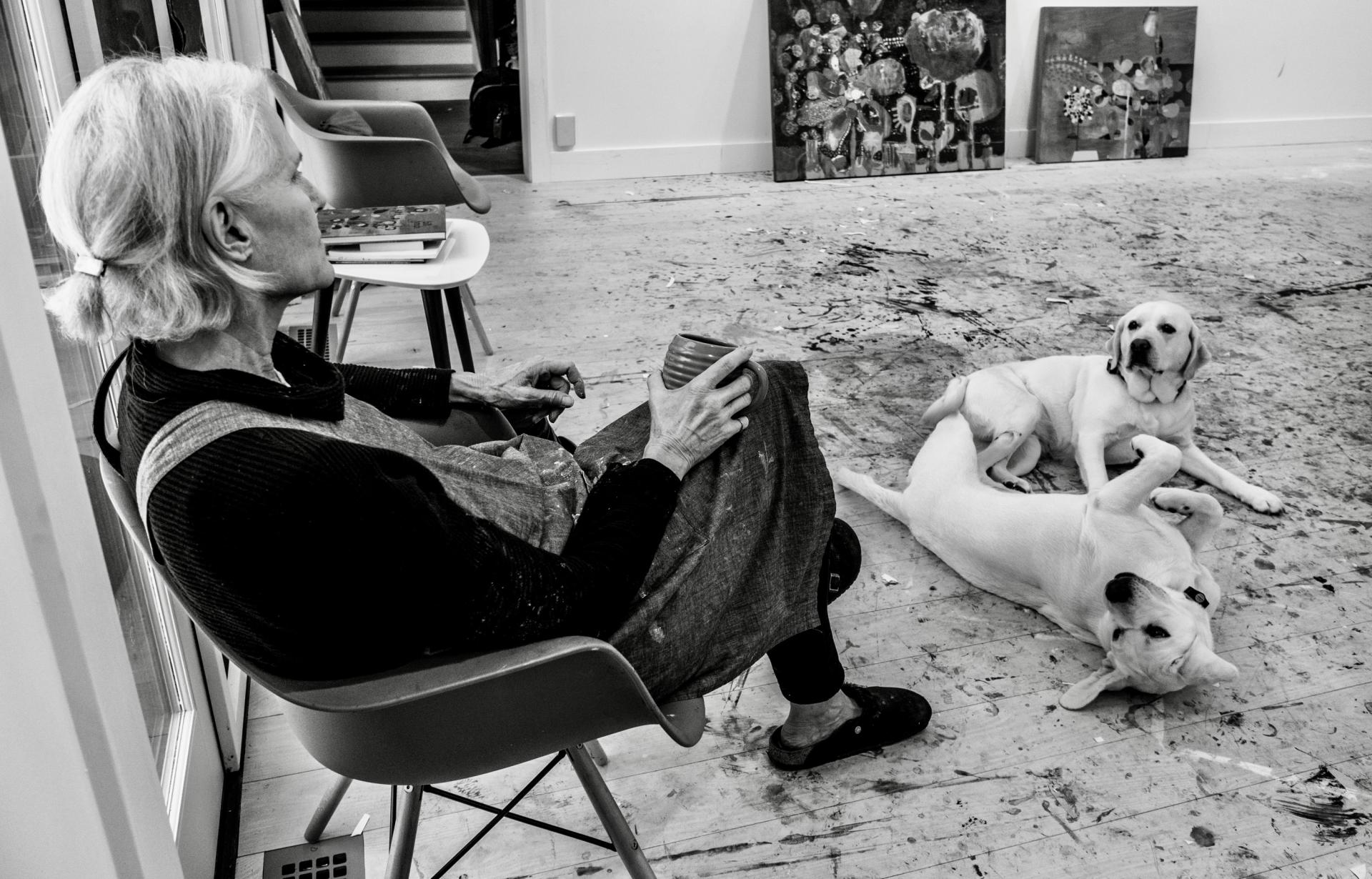You are here
Perennial Joy: Cynthia Wick in Bloom (Once Again)
Perennial Joy: Cynthia Wick in Bloom (Once Again)
Cynthia Wick at home in her Lenox, Mass., studio. (Peter Baiamonte Photography)
By Hannah Van Sickle
Despite myriad differences among the two dozen canvases dotting the walls of Cynthia Wick’s studio, an invisible tie binds each to the next. Amidst layers of bright acrylic paint, buried beneath bits of embellished paper, there resides palpable joy, which — considering the artist’s generous and open disposition — makes perfect sense. Viewed in the context of when the paintings were created? Now that begs a bit of a backstory.
“How does one make beautiful art in the face of such darkness?” is the wholly rhetorical question Wick wrestled with in the days and weeks after the pandemic descended in March 2020. “I almost decided not to paint anymore,” Wick admits, citing the deep devastation she felt in the wake of countless COVID-related deaths coupled with the tumultuous politics at play in this country. Equally accustomed to political activism and painting, Wick at first thought she had to choose one or the other before endeavoring to simultaneously employ her pair of penchants — a realization at the root of her show, “FLORABOREALIS” in the Center House Leonhardt Art Galleries at Berkshire Botanical Garden June 30 through Aug. 27.
“It was essential to mine my memory,” says the former en plein air painter who, after relocating from Los Angeles to the Berkshires 13 years ago, spent many years painting landscapes — largely inspired by her living on the edge of a forest and slowing down enough to notice the details. “I became much more observant about the light and color in the woods, and it really drew me in,” Wick explained during an early March visit to her studio. These days, she’s less interested in painting what she sees and more keen on accessing what’s inside. Standing in stark contrast to the bare branches and colorless snow outdoors, a distillation of the artist’s feelings unfurls from a paint-splattered easel-turned-epicenter.
Wick neither aspired to paint flowers, nor does she have a green thumb. Some of her earliest memories are of being just a head taller than the boxwood hedges surrounding her parents’ rose garden in California, “and seeing [those] giant flowers.” Touching upon the practice fueling her most recent body of work, she makes “an effort to access my sense memory about beauty … and moments in my life that were incredibly inspiring.” She speaks of a conscious decision to think less and listen more “to the inklings inside.”
Gone is an antiquated allegiance to recreating the immediate moment. Of late, Wick is focused on the process of creating art as opposed to producing paintings. Each canvas gains character loosely; when a particular color speaks to her, Wick runs with it — an approach she likens to “a constant effort to let the paintings tell [her] what they want.” The end result is a playfulness that’s alluring.
Take for instance, “In the Garden of the Space Angel,” a canvas Wick walks away from in order to gain perspective. “If you stand back, you can see it more clearly,” she says, pointing to a figure that showed up rather unexpectedly (from an inner-city garden) and made the artist laugh. A long time ago, Wick would have painted him out; today, she’s evolved in her approach. “I've learned that when those little — and often they are figurative — [details] emerge, they're a part of the history of the painting,” she says, leaning heavily into the big picture and loosening her grip. “I'm letting those stay,” she admits of a shift that made painting “way more exciting” in recent years.
Over more than two decades painting full-time, one thing remains constant: Wick’s intuition is razor sharp. While a daily meditation practice keeps her grounded, her spirit is open to the myriad ways in which her current medium, paint and painted-paper collage, can take shape on any given day. She likens it to a call-and-response exercise for musicians. “Something will occur to me in an earlier phase,” she says enthusiastically, pointing to several yellow painted-paper squares placed in the corner of a nearby canvas, “and then all the paint chatters with that, and it’s like a back and forth between the layers and layers and layers of paint and the hard edges of a little piece of flat paper.” And, when concerns about commerce do creep in, Wick returns to the wise words of the late Founder and Director of Art 101, Ellen Rand, in whose Brooklyn gallery Wick’s work was first shown: “Darling, it’s not about selling it’s about showing.” As a tangible tribute to that advice, Wick has been known to embellish her paintings with the small red dot stickers once reserved for marking a painting “sold” in galleries.
Come June, as the seasons shift and summer nears, the seeds for Wick’s show — sown more than three years ago amidst dark uncertainty — are slated to bloom, effectively punctuating the post-pandemic landscape with hope and optimism gleaned from within the proverbial storm. As for serendipity, Wick has taken up gardening. “Just two beds,” she says, evidence of a continued commitment to cultivating joy in the world. As to her parting words?
“Accolades are really nice, but you’ve got to paint what’s inside of you.”
Help Our Garden Grow!
Your donation helps us to educate and inspire visitors of all ages on the art and science of gardening and the preservation of our environment.
All donations are 100 percent tax deductible.



